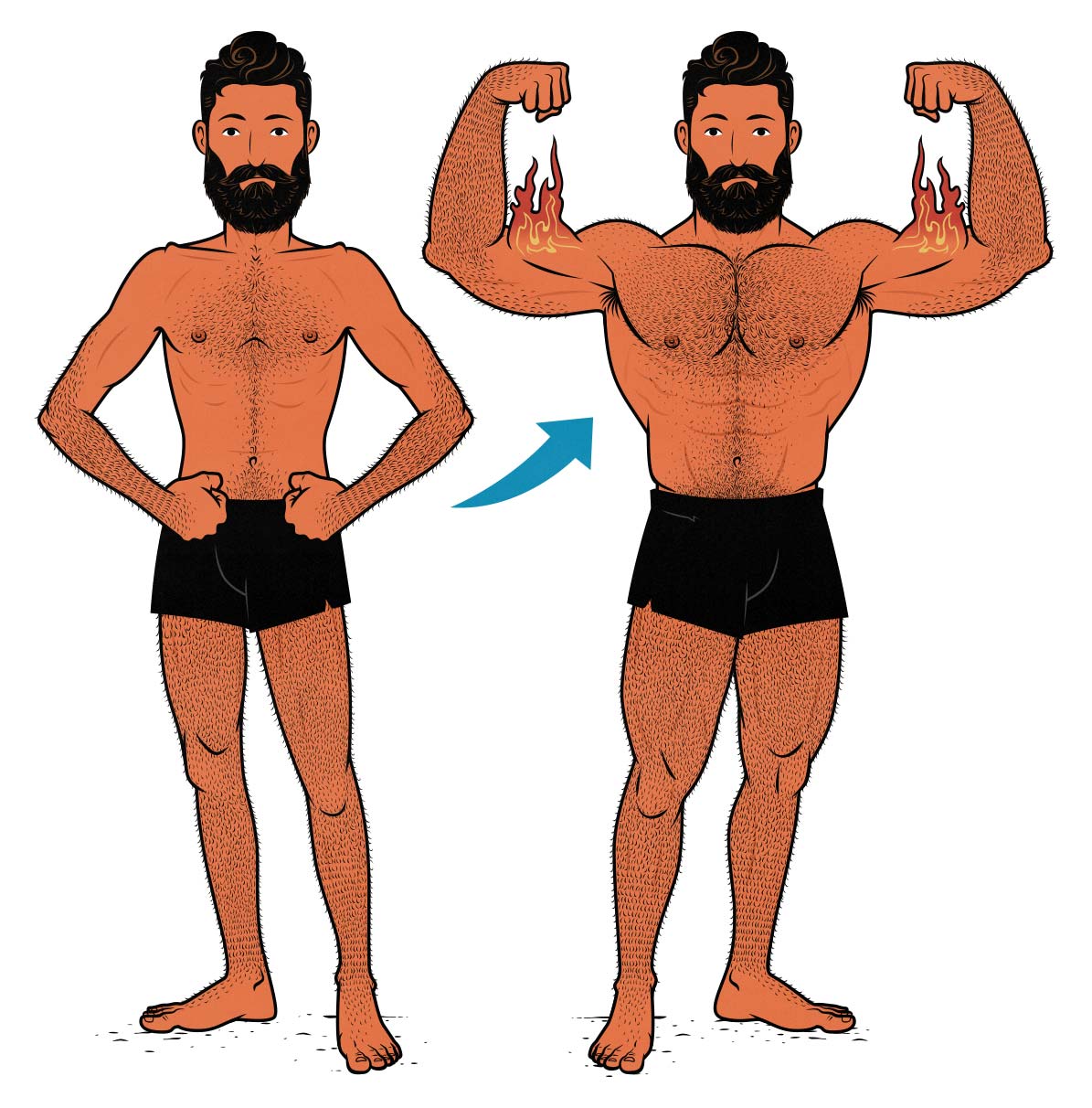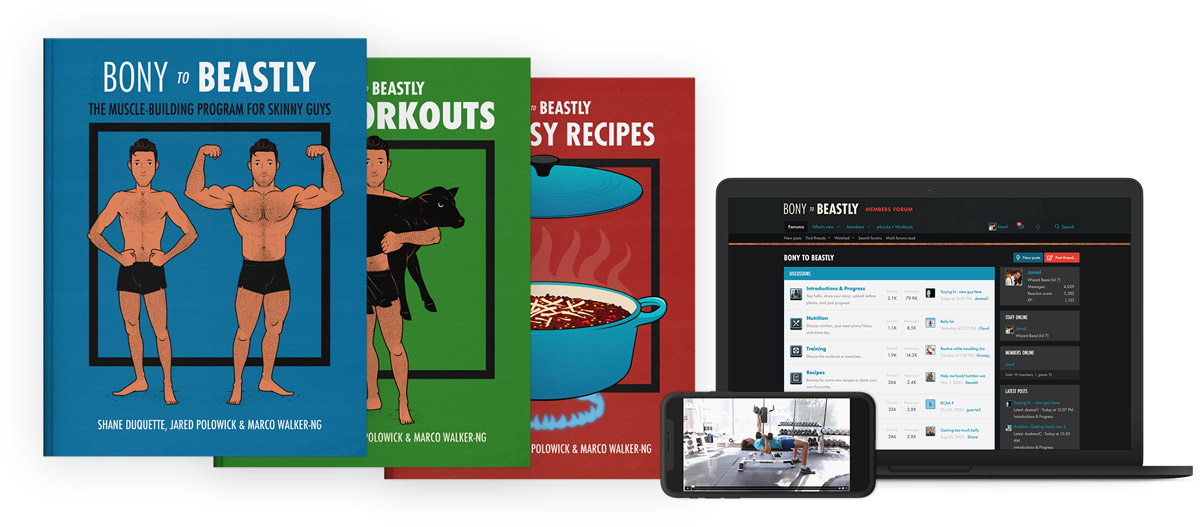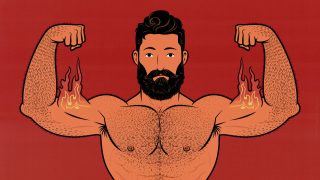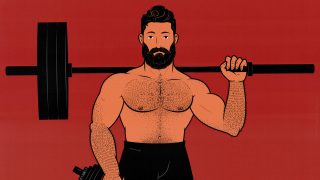
How Many Calories Do You Need to Build Muscle?
To build muscle, you need extra calories. Those calories don’t always need to come from food. Many of us carry quite a lot of extra energy in our guts. If that’s you, you’ve got plenty. You can listen to your appetite, eat a comfortable amount of food, and stimulate muscle growth with your training. No problem.
If you’re thinner or leaner, you’ll need to get the extra calories from your diet. That means you’ll need to eat in a calorie surplus—you’ll need to bulk. The size of that surplus is up to you. If you eat 100 extra calories every day, you’ll build muscle slowly and leanly. If you eat 750 extra calories, you’ll build muscle faster, but you may also gain more fat. I’ll give you some options below.
Now, here’s where it gets tricky. To eat in a calorie surplus, you need to build on what you’re already eating. One approach is to take your current diet and increase the serving sizes or add snacks. Another approach is to count calories. Both methods work.

The Calorie Calculator
Here’s the calorie calculator. It isn’t better than other calorie calculators, but it is better for you because it’s specifically designed for people trying to build muscle. I’ll go over all of the research and justifications below, but if you want, you can calculate your calories right away:
Muscle Wizard
Calorie Calculator
Calculating Your Calorie Needs
Calories Burned at Rest (RMR)
The most common calorie formulas factor in your age, gender, height, and weight. This can make them seem more precise, but it actually has the opposite effect (study).
- Your age doesn’t directly affect how many calories you burn (study). It’s just that older people tend to move less, be less muscular, and be in worse shape overall. If that doesn’t describe you, it makes the calorie calculator less accurate.
- Your gender doesn’t directly affect how many calories you burn, either (study). At least not to a meaningful degree. It’s just that women tend to have less muscle mass and more fat.
- Your weight and height do directly impact how many calories you burn.
If you’re trying to build muscle, these proxies for muscularity add a layer of confusion. Better to plug in your weight and body-fat percentage directly. That will give you a much more accurate idea of how many calories you’re burning.
Physical Activity Factor
The next issue is your activity level. Most calorie calculators begin with your resting metabolic rate (RMR) and then multiply it based on how active you are. If you’re a novelist who goes on a walk every day, you might multiply your RMR by 1.3. If you’re a gravedigger, you might multiply your RMR by 1.9. That’s great. But if you’re trying to build muscle, you’ll be working out. We want to factor that in, too.
We’re going to use the approach I learned from the research reviewer Greg Nuckols (reference). He argues that if you exercise, it’s better to split the Physical Activity Factor into Lifestyle and Exercise:
| Activity Level | Description | Multiplier |
|---|---|---|
| Sedentary | Almost always sitting and very little physical activity | 1.2 |
| Moderately Active | Sometimes sitting and some physical activity | 1.4 |
| Active | Usually on your feet doing physical things | 1.6 |
Your lifestyle can have a huge impact on how many calories you burn. From there, we can add in the calories we burn through deliberate exercise. A good muscle-building program will bump up your multiplier by another 10–20%:
| Training | MacroFactor Correction |
|---|---|
| 0 sessions/week | 1 |
| 1–3 sessions/week | 1.1 |
| 4–6 sessions/week | 1.2 |
| 7+ sessions/week | 1.3 |
If you like this approach to tracking calories, Greg is full of great ideas. His MacroFactor App calorie-tracking app is fantastic. We’ve got around 100 members trying it, using it to track their calories while building muscle, and they’ve been loving it. If you want to try it, you can get an extended free trial with the code “b2b”.
How Big Should Your Calorie Surplus Be?
That brings us to the final and most controversial point. Now that you know how many calories you’re burning, how many extra calories should you eat? How quickly should you gain weight? I wrote an article on Bony to Beastly covering all the research. I’ll summarise it here.
- Overweight or Skinny-Fat: As I mentioned above, if you’re already overweight, skinny-fat, or carrying living energy around your waist for any other reason, then you don’t need a calorie surplus at all. Eat according to your appetite and try to get gradually stronger. It’s okay if you gain or lose a little bit of weight. The important thing is to focus on progressive overload.
- Fit People: If you’re in decent shape, you may need to eat in a calorie surplus to build muscle. You don’t need a huge surplus, so decide between a slow or moderate pace. If you bulk slowly, your gains have a better chance of being leaner. If you bulk at a moderate pace, you have a better chance of building muscle faster. (Remember that the quality of your workout program is an enormous factor, as are your diet and lifestyle.)
- Thin People: If you’re skinny, thin, or underweight, your frame has more room for muscle growth, allowing you to benefit from bulking more aggressively. We’ve got a separate calorie calculator for you.
That gives us a table that looks something like this:
| Method | Goal | Body Type | Surplus |
|---|---|---|---|
| Recomp | Build muscle while losing fat | Overweight or skinny-fat | Don’t Track |
| Lean Bulk | Leaner, slower muscle growth | Everyone | +200 calories |
| Classic Bulk | Muscle growth | Fit or thin | +500 calories |
| Aggressive Bulk | Fast muscle growth | Thin or crazy | +750 calories |
What if You Aren’t Gaining Weight?
This calorie calculator does a pretty good job of estimating how many calories you need to build muscle. However, it isn’t perfect, and neither are we. Even if you’re tracking your calories with an app, and even if that app uses a verified food database (as MacroFactor does), there’s still a margin of error. That’s why we need to be adaptive.
Progressive Caloric Overload
As you gain weight, you’ll burn more calories. There’s a very simple reason for that: you need to carry that extra weight around. Plus, muscle is metabolically active, burning around 6 calories per day at rest (study). All told, a pound of muscle burns around 12 calories per day. That’s an extra 60 calories for every 5 pounds you gain.
There’s another factor to consider, too. As you get used to eating more calories, your metabolism might start spending those calories more freely, especially if you have a body type that resists fat gain. I’ve written about that on Bony to Beastly. This can further increase your calorie needs.
The point is, as you continue building muscle, you’ll need to gradually increase your calorie intake.
Weigh Yourself & Adjust
Weigh yourself at least once per week. The way I do it, and what we recommend in our bulking programs, is to have an official weigh-in at the end of every week. For example, every Sunday morning, right after waking up, you’d step on the scale and record your weight. Your weight will fluctuate. It won’t be perfect. But weighing yourself under similar circumstances every week does a pretty good job of removing confounding factors.
The reason I recommend weighing yourself just once per week is because it gives you a clear goal to aim for. During the week, you’re working towards your weigh-in. It’s motivationally powerful.
Another approach is to weigh yourself every day and track your average weight. By keeping a rolling average, you’ll get a more precise idea of how your weight is changing.
Summary
If you’ve got a surplus of body fat, you don’t necessarily need to worry about eating extra calories. Follow a good hypertrophy training program, eat a good diet, and live a healthy lifestyle. If you’re gradually gaining strength, you’re doing great.
If you’re thin or lean, you do need to eat extra calories. You’ll want to eat between 200 and 750 extra calories per day, depending on how leanly or quickly you’re trying to build muscle. You can get into a surplus by keeping your meal schedule the same and eating larger meals. If that’s hard on your stomach, I recommend keeping your meal sizes the same but adding extra snacks.
If you want to be more precise with your calorie intake, you can track them. The calorie calculator above will give you a good idea of how many calories you’ll need to eat to build muscle. But you’ll also need to use a calorie-tracking app. We’re affiliated with MacroFactor. It’s easily the best on the market. You can get an extended free trial with the code “b2b”.
I’ll note that I don’t track my calories. I prefer to eat similar meals on a consistent schedule every day. If that stops being enough, I add more calories in. However, I’ve tracked my calories in the past, and I’m still thankful that I did. I have much greater calorie awareness than I did before. It improved my nutritional intuition, and I still benefit from that many years later.

Alright, that’s it for now. If you want more muscle-building information, we have a free muscle-building newsletter. If you want a full exercise, diet, and lifestyle program to help you build muscle and improve your health, check out our Bony to Beastly Program (for guys) or Bony to Bombshell Program (for women). Or, if you’re already an intermediate lifter, check out our Outlift Hypertrophy Program.
Shane Duquette is the co-founder of Outlift, Bony to Beastly, and Bony to Bombshell. He's a certified conditioning coach with a degree in design from York University in Toronto, Canada. He's personally gained 70 pounds and has over a decade of experience helping over 10,000 skinny people bulk up.






Great calculator, thanks for the article! I’m only a 5 foot female but maintain at 2700 cals. This is the only one I’ve used that gave me a similar result.
Others I’ve used are so inaccurate using neck, wrist, waist measurements etc. I’ve even had one that yielded an ‘obese’ result!
I’m not obese. I’m actually broad shouldered and wide hipped for a female, relatively lean at low 20s body fat and quite heavy because I’m muscular from lifting weights!
Great site, thanks for all the time and effort you’ve put into this site, it’s invaluable!
Woot! Glad it helped, Amy.
You’ve got a robust metabolism. That’s great but rare. Not rare for fit, active people who lift weights, but rare among the general public. That’s where calorie calculators like this one do really well.
Let me know if there are any other topics you want covered 🙂